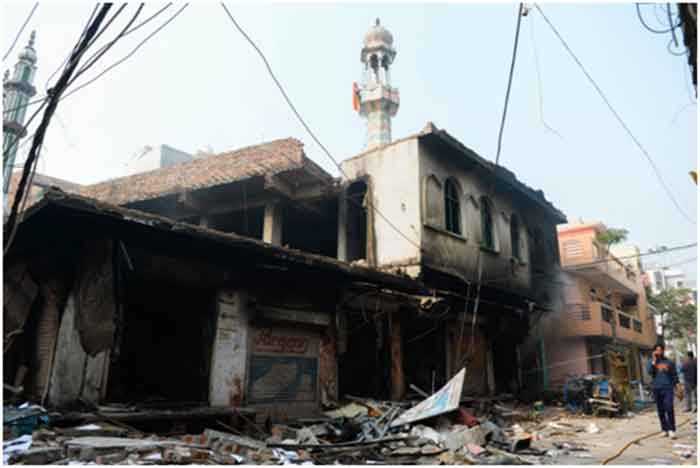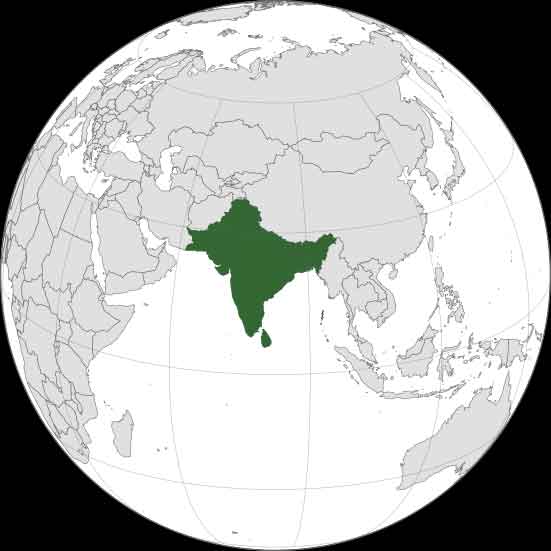
Image of the recent destruction of Hindu Temple in Comilla, Bangladesh. Source: The Free Press Journal

Image of destruction of Muslim properties during the 2020 anti-Muslim riot in Delhi, India. Source: Al Jazeera
In Bangladesh, former East Pakistan where bulk of Pakistan’s Hindus belonged once, violence against its minority, mainly the Hindus (9% or 14.7 million of its total population of 165 million) are not that frequent, but not that uncommon either but the recent October 13, 2021 communal violence in Comilla, a district headquarters town in Bangladesh, was remarkably vicious and unique in the sense that it involved an act of deliberate sacrilege – something that has never happened before – that triggered vicious anti-Hindu violence right across the country.
In India, the sectarian violence against the Muslims, a minority (213 million or 15.5% of the population), are indeed a common occurrence since 1947, the year the sub-continent was partitioned into Hindu majority/Muslim minority India and Muslim majority/Hindu minority Pakistan. However, violence against Muslims in India seems to have gained momentum since 2014, the year, the Modi and his Hindu nationalist party came to power.
As has been stated above violence against the minorities in either of these two neighbouring countries – Bangladesh and India – are not uncommon just that in recent years attacks against the minorities in these two countries seem to have become more vicious and audacious.
The question is, why?
Violence against Hindus in Bangladesh
On October 13, 2021, the most recent attack on Hindus, which happened on the eve of the Durga Puja, the biggest Hindu religious festival, was triggered by a video clip that went viral in social media. The clip showed the Quran, the holy book of the Muslims at the feet of one of the Hindu deities at a Puja Mandap (place of worship) in Comilla, a district town in Bangladesh. The clip triggered a series of deadly communal attacks on Hindus, Hindu temples, and their properties, initially in Comilla and later, all over the country. These attacks destroyed many Hindu temples and Hindu properties. Many Hindus were hurt, some fatally.
In most cases, police were late in responding and in some places, they opened fire on the rioters, killing five, all Muslims. Two Hindus also lost their lives at the hands of the rioters.
Violence against the Hindus in Bangladesh are not uncommon, but this year’s attacks have been particularly vicious and the Comilla Quran incident that triggered the countrywide violence is both unique and intriguing and this is mainly because, firstly, no Hindu would put Islam’s holy book, the Quran at the feet of a Hindu deity, for this would be a sacrilege in Hinduism; nor would a Hindu dare such an audacious thing in a Muslim majority country, for such an act would invite violent backlash; and secondly, no puritan Muslim would put the Quran at the feet of a Hindu deity, for this would be an act of gross affront to Islam.
So, who did it?
Bangladesh government has nabbed a suspect, one Iqbal, a Muslim, allegedly, a mentally unstable person.
Iqbal was arrested based on CCTV footage that, according to the police, matched his image. However, many doubt the authenticity of the footage and most importantly, in terms of possible motive, nothing has so far been disclosed to the public by the authorities, beyond saying that the suspect being mentally unstable.
Another interesting, if not an intriguing, feature of the Comilla incident is that this time, the attackers were not the usual long-robed, bearded Muslims (often branded, ‘Islamist terrorists’) but that they were mostly young kids in jeans and polo shirts and more intriguingly, some of these rioters who have since been arrested by the police have turned out to be the local activists of the ruling party. Yet another unique aspect of this year’s anti-Hindu violence in Bangladesh is that contrary to previous experience, the long-robed bearded Muslims were seen guarding Hindu properties and their places of worship in several places.
These contradictory aspects – ruling party activists rioting and the Mullahs guarding the Hindu places of worship – make this year’s attacks on Hindus in Bangladesh somewhat complex if not intriguing and raises questions regarding the real identity of the perpetrators, their background, and the agenda.
The Bangladesh Hindu Unity Council has reacted to the violence angrily and rightly so and stated that, “the Hindus of Bangladesh saw the real faces of some people. We don’t know what will happen in the future. But the Hindus of Bangladesh will never forget Durga Puja in 2021.” Rightly so.
Sheikh Hasina, the Prime Minister of Bangladesh, has condemned the violence and promised, “The incidents in Comilla are being thoroughly investigated” and the attackers “…will be hunted down and punished.”
Hopefully, the real criminals would be caught, and the perpetrators, especially those who planned and organized the Comilla Quran desecration that triggered the countrywide anti-Hindu violent backlash, would be brought to justice, and punished.
The Hindu vulnerability
There are many factors – some historical and some more contemporary – that have contributed to the vulnerability of the Hindus in Bangladesh. For example, partition of India into Hindu Majority/Muslim minority India and Muslim majority/Hindu minority Pakistan disempowered Hindus in Pakistan, who were mostly in the then East Pakistan, now Bangladesh.
During the 25-year long Pakistan regime Hindus were at the lowest rung of the society though and this is interesting, that during the Pakistan period communal violence against Hindus were at the minimum.
Ironically, anti-Hindu violence has spiked mainly since 1971, after the separation of East Pakistan from Pakistan and establishment of Bangladesh, a country that made secularism its key governing parameter, where people of all faiths were expected to live equitably and in harmony. This was not to be, and I believe that the reason for non-fulfillment of the pledge may be due to – firstly, most Bangladesh governments have failed to adhere to the principles of the rule of law and flouted democratic accountability that weakened the rights of people, increased vulnerability and compromised the safety and security of most citizens, especially those who are disadvantaged and powerless, including the Hindus and secondly, there are trust deficits between the Muslims and the Hindus that also be contributing to the deficits of empathy.
While it is true that the present Bangladesh government has made secularism its key policy pillar, at least rhetorically, and took steps to “mainstream” Hindus, inclusive policy might not have gone far enough. Rather its favours to Hindus have been done selectively that many believe have been driven more by political opportunism than genuine inclusion and that these selective pampering of the Hindus have been undertaken mainly to appease its patron, the BJP government of India that according to many helped the current Bangladesh government to go to power. As a result, some argue that therefore, the government has taken the policy of either abating or looking the other way, the persecution of Muslims in India that occur daily.
Against this backdrop the perception – rightly or wrongly – that the Hindus in Bangladesh who are blind supporters of the government and many also believe that their loyalty is more with India than Bangladesh promotes spawn distrust among the Muslims and vis-à-vis the Hindus in Bangladesh, especially at the community level.
Furthermore, some also argue that the present Bangladesh government that aggressively persecutes the opposition, mainly the Islamist nationalists[1] and the fact that no Hindu organizations have ever taken a stand against these human rights abuses of the government and on the contrary, sides with the government mostly, have not quite helped their cause in earning the respect and trust of the majority of the Muslims in Bangladesh, either.
Many Muslims in Bangladesh also believe, rightly or wrongly, that the Hindus who are part of a governing nexus that tramples democratic norms, sucks up to India that persecutes Muslims and condones suppressing “Bangladeshi Nationalism”, a euphemism for Muslim cultural identity for the Bangladeshi nationhood are therefore, not completely wedded to the notion of a democratic and nationalist Bangladesh. Such a notion is indeed unfortunate but not an uncommon and the fact that Bangladeshi Hindu organizations have never taken stand against nor protested ever the persecution of Muslims in India, where like them, a minority, distances the two communities from each other even more.
In other words, in Bangladesh, vulnerability of and violence against Hindus that are not that uncommon and have become more vicious in recent times occur for two main reasons: firstly, because of lax rule of law that compromises the democratic rights and safety and security of all people, including those of the Hindus; and secondly, trust deficits that keep the two communities apart increase the vulnerability of the Hindus at the community level.
In addition, it is also true that like most societies, there are hate mongering extremist Muslims in Bangladesh that spew sectarianism but these are easily controllable provided there is rule of law and there is mutual respect and trust between the two communities, the Muslims and the Hindus at the community level so that it’s the people who take care of and protect each other.
Violence against Muslims in India
In India, sectarianism and the marginalization of Muslims are both structural and cultural and as stated before, has been the case since the partition of the sub-continent in 1947 into Hindu Majority/Muslim minority India and Muslim majority/Hindu minority Pakistan.
In Hindu majority/Muslim minority India, Muslims remained an underprivileged class right from the beginning but thanks to the efforts of one Indian government led by the Prime Minister Manmohan Singh when efforts were made to assess and document the prolonged “backwardness” of the Muslims, not merely for moral reasons but for economic reasons as well.
There has been a realization that prolonged inequities of a large segment of the population are bad for the economy and bad for the society and thus the Congress government under the leadership of Prime Minister Manmohan Singh formed in 2004, a high-powered committee, the Sachar Committee, to study the social, economic, and educational lags of the Indian Muslims and recommend measures to improve their conditions and bring them, to the extent possible, at par with the majority population, the Hindus.
The Sachar Committee revealed that both economically and socially Indian Muslims are at the bottom, below the Dalits (the low caste-Hindus) and that the Hindu/Muslim inequities in India are structural and are embedded within the body politic, as well as the economic and social fabric of the society.
The Committee submitted its report to the Parliament in 2006 with a set of recommendations to “mainstream” the Muslims.
Sadly, not a single recommendation of the Sachar Committee has so far been implemented and on the contrary, some Hindu nationalist leaders have derided the Report being a “whim” of the Prime Minister Manmohan Singh and declared that the Sachar Committee itself, is “unconstitutional”.
As a result, and far from “mainstreaming”, no progress worth the name has been made to address Muslim inequities. On the other hand, things took a turn for the worse when Modi and his Hindu nationalist party, the BJP came to power in 2014 (and continuing) and introduced policies, ideologically packaged as, Hindutva, that are pronouncedly, anti-Muslim.
Modi’s policy of ‘Hinduisation’ of India
Modi’s Hindutva policy, a populist sectarian agenda that promises Hinduisation of India is indeed a communal nationalist policy by any definition. It brands Muslims, the largest minority in India as ‘invaders’, and ‘aliens’ and endeavours to promote Hindus, as the true representatives of India and Hinduism, the only identity of India and the policy has since made marginalisation and persecution of Muslims, an official if not a moral imperative for the Hindus in India.
Modi has a long history of hostility towards the Muslims. Before becoming the Prime Minister of India, he was the Chief Minister of Gujrat, an Indian state where in 2002, a vicious anti-Muslim riot killed close to 2000 Muslims – men, women, and children – and scores were injured, and hundreds of Muslim properties burned and destroyed. The carnage happened under the very eyes of Modi; and some suggest, with his endorsement.
After becoming the Prime Minister of India in 2014, Mr. Modi simply transported his Gujrat anti-Muslim ideas to Delhi and made these ideas a national programme of Muslim pogrom of a sort.
He introduced series of policies[2] such as the Citizenship Act that has given the government the authority to question citizenships of Muslims, anywhere anytime, a policy that has since has since rendered many Muslims stateless, overnight and many are languishing in processing centres – a euphemism for concentration camp; prohibited beef eating – Cow is an important Hindu deity but a favourite diet of the Muslims and made beef eating and anything to do with a Cow by a Muslim, a crime; and more recently, Modi government has revoked the autonomy status of Kashmir (a Muslim majority state in India) and brought the state under direct Delhi rule, making the change a project of collective disenfranchisement of Muslims.
Collectively, these Hinduisation measures have since set the stage for the institutionalised persecution and incentivised the lynching, murdering, and harassing of Muslims all over India and more particularly, in the Hindi-Hindu belt of northern India, with such regularity and impunity that the United States Commission on International Religious Freedom (USCIRF), an independent, bipartisan federal government commission, has recommended “India be placed on a religious freedom blacklist for the second year in a row”.
Lately, the Hindutva steroid has extended its venom on the Urdu language, which is constitutionally, one of the 14 official languages of India and is spoken mainly by the Muslims and a language that grew in India during the Mughal period. However, according to the Hindutva crusaders, Urdu as a “Muslim culture” and therefore, its use in India is “culturally inappropriate” and “offensive to Hinduism.” The hyped- up Hindutva activists have since forced many Indian Fashion Brands to take their Urdu marketing advertisements down.
Another of BJP’s anti-Muslim initiative at the social/cultural front, is campaign against ‘love jihad’ – a euphemism for violent opposition to Hindu/Muslim inter-marriages/romance. Thanks to the rising Hindutva zeal, Muslim/Hindu interfaith liaisons and/or marriages are not just frowned upon, inter-faith couples encounter vicious physical assaults from the Hindutva guardians and much worse, a court in India has also joined the Hindutva cabal and ruled against inter-faith marriages.
Furthermore, and quite ironically, Modi government’s anti-Muslim policies that are designed to promote Hindu supremacy in India are now threatening the safety and security of Hindus in the neighbouring Bangladesh, a Muslim majority country where Hindus are a minority such that Sheikh Hasina, the Prime Minister of Bangladesh, has warned, “India must not do things that threaten the safety and security of our minority, the Hindus”.
It is time that Mr. Modi, his BJP activists, and his millions of supporters who believe in Hindu supremacy and Muslim persecution and abolition of Muslim culture and identity the way to achieve India’s Nirvana are not just dead wrong but such an agenda is suicidal for no country has ever progressed, neither economically nor culturally by persecuting and dividing its own people, let alone a country such as India where the Muslims constitute 14% or 200 million of its population and are an integral part of the country’s economic and social growth.
Indeed, India needs an urgent reset – it needs to abandon sectarianism and promote inclusion, and, in this regard, they are fortunate that they already have a roadmap. All they need to do is dust off the Sachar Report and implement its recommendations and “mainstream” the Muslims so that India is re-united and journeys politically, economically, and spiritually together and grow as a strong nation. A strong and united India is good for India and good for the world.
Sectarianism is a sickness, must be rooted out
Finally, regardless of whether it occurs because of failure of a government to adhere to and administer fairly and stringently the rule of law and guarantee the safety and security of all people including the minority equally (as in Bangladesh) or that the scourge is inspired by the state itself (as in India), sectarianism is a sickness that regresses a nation, for as Nelson Mandela once reminded, “When we lose the right to be different, we lose the right to be free and productive.”
The author is a former senior policy manager of the UN
[1] “The Government of Bangladesh is responsible for multiple human rights violations, including unlawful killings and disappearances, arbitrary arrest and detention, and torture.” Amnesty International
[2] https://www.cfr.org/backgrounder/india-muslims-marginalized-population-bjp-modi
















































